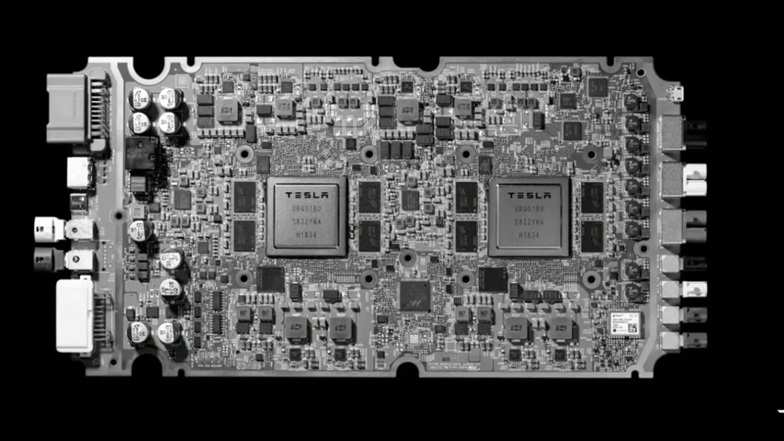Tesla has long been at the forefront of EV innovation, with its Tesla Full Self-Driving (FSD) technology touted as a game-changer in the automotive industry. However, a significant flaw in Tesla’s latest onboard FSD computer, known as AI4.1, has left customers grappling with compromised vehicles and mounting frustrations. This issue, which has persisted for months, has not only disabled critical features but also impacted battery performance, raising concerns about Tesla’s ability to handle such setbacks efficiently.

What Went Wrong with Tesla’s FSD Computer?
Reports first surfaced in July about a major defect in Tesla’s AI4.1 FSD computer, affecting newer Model Y and Model 3 vehicles. The problem stems from an internal short circuit in the computer, which can occur within just a few miles on a brand-new car or after several thousand miles of driving.
When the computer fails, a host of essential vehicle features become inoperable, including active safety systems, cameras, GPS navigation, and range estimation. For Tesla owners, this isn’t just an inconvenience—it’s a potential safety hazard, as features like backup cameras are legally required by the National Highway Traffic Safety Administration (NHTSA).
Tesla’s response has been to replace the faulty computers entirely. While the company has also implemented a temporary software fix to restore limited functionality, this approach falls short of providing a long-term solution.
How Many Vehicles Are Affected?
The full scope of the issue remains unclear, but initial estimates suggest that thousands of Tesla vehicles could be impacted. Customer complaints have flooded forums, NHTSA’s Tesla Model Y and Model 3 pages, and Tesla’s own service channels.
Despite the scale of the problem, Tesla has yet to issue a formal recall or service bulletin. This lack of communication has added to customer frustrations, particularly since NHTSA requires automakers to address defects in safety-critical features.
Electrek, a prominent EV news outlet, reached out to NHTSA to inquire whether they are aware of the issue. While no official statement has been released, the growing number of complaints underscores the urgency of the matter.
The Consequences for Tesla Owners
For affected Tesla owners, the computer failure is more than just a technical glitch—it significantly disrupts their driving experience. Without a functioning FSD computer, vehicles are essentially handicapped, lacking features that are integral to their operation.
Adding to the inconvenience is the lengthy wait for replacements. Tesla has informed customers that the new FSD computers are in short supply, leading to repair appointments being scheduled months in advance. Some owners have shared documentation showing replacement appointments delayed until February, leaving them without fully operational vehicles for over two months.
Battery Drain and Other Complications
The defective FSD computer doesn’t just disable features—it also causes other headaches for owners. Many have reported their vehicles being stuck in an “auto-update loop,” which continuously drains the battery.
One Model 3 owner estimated that his vehicle consumed about 5 kWh per day while parked due to the faulty computer. For context, this is a significant drain for an idle EV and poses additional challenges for those without home charging capabilities.
Concerns about faster battery degradation and wear on other components have also emerged. Excessive battery drain not only increases charging costs but could also reduce the overall lifespan of the battery, a key component of any electric vehicle.
Tesla’s Response and Next Steps
Internally, Tesla has acknowledged the issue, identifying it as an “internal short” in the FSD computer. However, its outward communication with customers has been limited, leaving many frustrated by the lack of transparency.
While Tesla’s replacement strategy addresses the root cause, the delays and scarcity of parts highlight a broader issue with the company’s supply chain and service infrastructure. For a brand that prides itself on technological innovation, resolving this problem quickly and efficiently is critical to maintaining customer trust.
This incident raises important questions about Tesla’s quality control and its ability to handle large-scale technical issues. As the leader in the EV market, Tesla sets the standard for innovation, but its handling of this FSD computer failure suggests room for improvement in post-sale support.
For the affected owners, this situation has been a reminder that cutting-edge technology comes with its own set of risks. Tesla’s commitment to pushing boundaries is commendable, but ensuring reliability and safety must remain a priority.
What Should Tesla Do Now?
To regain customer confidence and address the problem effectively, Tesla should take the following steps:
- Issue a Formal Recall: Acknowledging the issue publicly and working with NHTSA to address safety concerns will demonstrate accountability.
- Improve Communication: Proactively updating affected customers on the status of replacements and temporary fixes will reduce frustration.
- Strengthen Supply Chains: Increasing the availability of replacement computers will minimize repair delays and improve service efficiency.
- Enhance Quality Control: Conducting rigorous testing before rolling out new technology can prevent similar issues in the future.
Tesla’s FSD computer issue is a stark reminder that even the most advanced automakers are not immune to setbacks. For customers, this has been a challenging experience that underscores the importance of robust support systems for high-tech vehicles.
As Tesla works to resolve the problem, the company has an opportunity to demonstrate its commitment to quality and customer satisfaction. While innovation is essential, ensuring reliability and safety is equally crucial in earning and maintaining the trust of EV enthusiasts worldwide.
Tesla’s response to this issue will likely shape perceptions of the brand moving forward, making it a pivotal moment for the company.
Related Post
